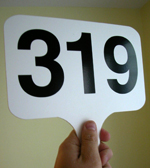How to behave at an auction
Huon Mallalieu explains the ins and outs of how to bid at auction


Not so long ago, one could walk into a saleroom a moment before an interesting lot came up, and bid without any preliminary formalities. If successful, one called out one’s name and settled the account at the sale’s end. Nowadays, prospective bidders usually have to register beforehand, producing proof of identity and a credit card in exchange for a card (or ‘paddle’) with a bidder’s number. This is to discourage fantasy bidders and weed out the uncreditworthy.
The old canard that an unthinking nod or a sneeze will be taken as a bid is nonsense. The auctioneer should be professional even if you are not. If in doubt, he will ask if you are indeed bidding. Make your first move distinctly, to ensure his attention, but do not get over-excited. Choose a place in the room where you feel comfortable. I like to stand at the side towards the back, so that I can assess the opposition and be seen clearly by the auctioneer. Some people, usually big dealers, prefer to sit at the front, which gives an impression of confidence, and may allow for a final look at the lots.
When he takes your bid which may not be at once, as etiquette demands that he stays with bidders until they drop out you may nod, raise a finger or flip your paddle as you prefer. When dropping out, indicate your decision distinctly. Remember that in the early stages, you may be bidding against the owner’s reserve price, and perhaps against bids left ‘on the book’ rather than opposition in the room, in which cases, the auctioneer will try to hurry proceedings.
Sometimes, it’s worth waiting until others have exhausted themselves, before coming in with the killer. If you are successful, hold up the paddle so that your number is recorded.
All rules have exceptions, but here are some guides
* Never bid without viewing, unless you are a real expert, or really have to take a gamble. When viewing, try not to get too excited if you think you have spotted a bargain, as this may alert others
* Decide on your upper limit and stick to it. That friendly auctioneer is there to cajole more out of you. When deciding, remember that your limit should include the buyers’ premium and the VAT on it
Exquisite houses, the beauty of Nature, and how to get the most from your life, straight to your inbox.
* Settle on a round figure plus one or two bids, that is to say £120 rather than £100. Note the conventional bidding increments before you bid. Sometimes, perhaps when a lot has not quite reached its reserve (the price below which a vendor will not sell), it is worth calling out a smaller increment, but the auctioneer may not accept it
* If ‘your’ lot fails to reach the reserve and is bought in (or ‘passed’), it may be worth making a post-sale offer
* Calm and cool are the watchwords
Country Life is unlike any other magazine: the only glossy weekly on the newsstand and the only magazine that has been guest-edited by His Majesty The King not once, but twice. It is a celebration of modern rural life and all its diverse joys and pleasures — that was first published in Queen Victoria's Diamond Jubilee year. Our eclectic mixture of witty and informative content — from the most up-to-date property news and commentary and a coveted glimpse inside some of the UK's best houses and gardens, to gardening, the arts and interior design, written by experts in their field — still cannot be found in print or online, anywhere else.
